Image manipulation with the intention to mislead has been around as long as photography. But, with more photographs taken today than ever before in the history of humanity and the ability of social media to spread misinformation like ever before, the need for today's journalist to be aware of techniques of photo manipulation, how to spot if a photograph has been manipulated and why is greater than ever.
In fact, this knowledge should be part of every single journalist's skill set in order for them to be able to tell news independently and factually. This chapter aims to introduce these skills and explain why they are important.
To do this, we must first consider the reality under which photojournalists in the Arab region work, identify their concept of the image and their understanding of journalism's mission.
From my work as a photojournalist for 35 years in Lebanon and the Arab World (25 years as a photographer and then as a photo editor at the Associated Press) and meeting with many foreign photographers of various nationalities, I came to realise that a large number of these photojournalists have acquired a vast photography culture in addition to the technical knowledge that is significantly easy to learn due to the proliferation of specialised institutes and the ease of communication in foreign languages.
This is different from photojournalists in the Arab World. Although some of them are knowledgeable about journalistic photography, its history and culture, others require more knowledge in this field, even if they use their equipment well.
As professional journalists, we must first and foremost understand photojournalism as a medium so that we may improve our credibility. As such, here we discuss the challenges that photos published by citizens pose to the journalist but also how professional journalists and governmental agencies have technology at hand to manipulate images we may wish to use.
Press Images
While images have always been manipulated, the manipulation and fabrication of press photographs since the beginning of this century has been on the increase. The Arab region is no exception here, with consecutive incidents of manipulation occurring in relatively short periods of time. This can be attributed to the following reasons:
-
Some photojournalists are unaware of the laws and covenants governing media work.
-
Some journalists are biased - either by their environment or by their social, political or national loyalty.
-
Journalists are unaware of incidents of image manipulation.
Examples of Photographic Manipulation
Here are some examples selected from the Arab World which are worthy of our study so that journalists do not fall into bad practices that may mislead the public and undermine their credibility and professionalism.
Case Studies: Professional photographers manipulating images
- Reuters – Lebanon 2006
A photographer who worked for the news agency Reuters in Lebanon was in a building overlooking the southern district when it was shelled by Israeli aircraft during the 2006 conflict. The photographer claimed to have taken several photographs to highlight the severity of the Israeli shelling of one of the sites - showing pluming black smoke. He then sent them directly to the Reuters bureau in Beirut.
Following distribution of the image amongst Reuters' subscribers, the Israeli government swiftly protested, saying that the image had been manipulated, noting that the type of munitions used in the shelling did not create such smoke. Reuters later confirmed that the image was in fact digitally manipulated using image manipulation software that had increased the quantity and volume of smoke, making it look thicker throughout the image.
The photographer said that the only alteration he made was removing some dust in the image caused by a dirty lens.
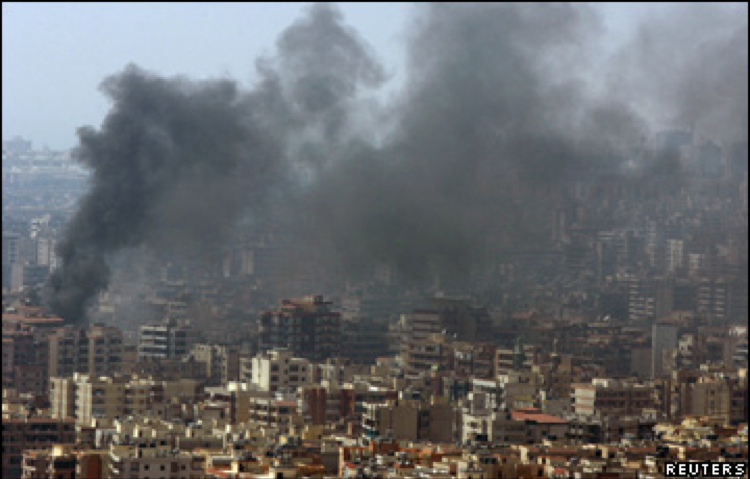
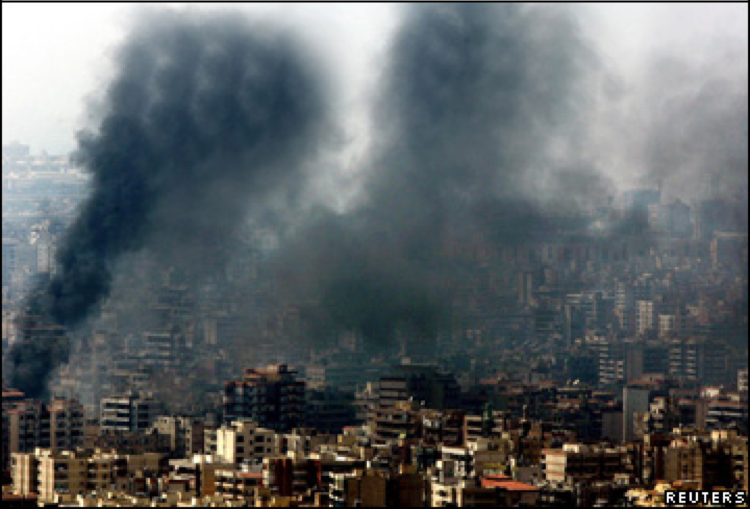
Reuters apologised and removed all the images taken by the photographer from its archive, a total of 920 images, and then cancelled its contract with him.
Modern technology allows journalists to distribute their images quickly - but this highlights a serious issue that all news organisations must be aware of.
The photographer was able to send his pictures to his client - enabling him to select the image he wanted. While photographers in the past had to bring the memory card or even the roll of film to the bureau directly where the photo editor would choose the image that told the best story of the incident, simultaneously monitoring the sequence of images and checking if they were manipulated. Today, with modern distribution technologies, more power sits in the hands of the photographer themselves to select and distribute the picture they choose.
- Associated Press – Syria 2014
In early 2014, the Associated Press announced the severance of its relationship with an independent photographer that the agency worked with in the Middle East. This came after the photographer admitted to altering an image from the conflict in Syria he took in September 2013.
The director of photography at the Associated Press said “Deliberately removing elements from our photographs is completely unacceptable."
The photographer’s confession that he amended an image and removed a video camera in the corner of an image showing an opposition fighter prompted AP to consider that the amendment was a violation of their principles and values. Through these values, AP maintains the credibility of its images without digitally amending them or manipulating their content in any form, whether by deletion or addition.
This photographer was among five photographers whose images on the war in Syria contributed to the Associated Press winning the Pulitzer Prize for Journalism in the breaking news category in the spring of 2013.
The photographer thought that the presence of a video camera in the frame would divert the attention of the viewers, and said: “I took the wrong decision when I removed the camera ... I feel ashamed about that”.
The fighter appeared to be taking cover in the image and beside him a video camera appeared of one of the photojournalists in a corner of the frame. However, the photographer changed the image by taking another piece of his image’s background and placing it over the video camera in an attempt to remove it, before sending that image to the Associated Press.
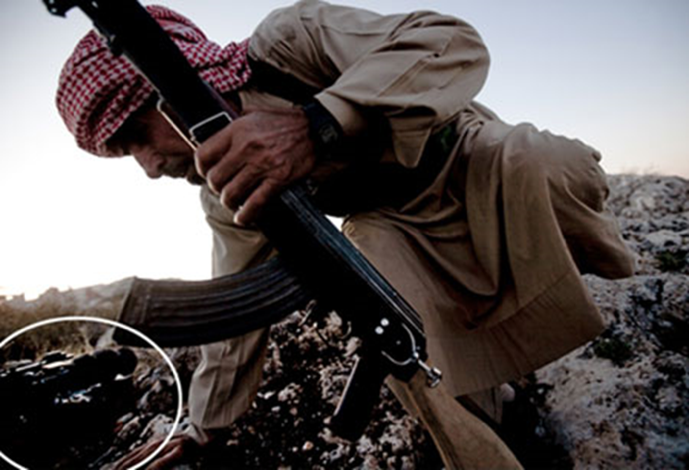
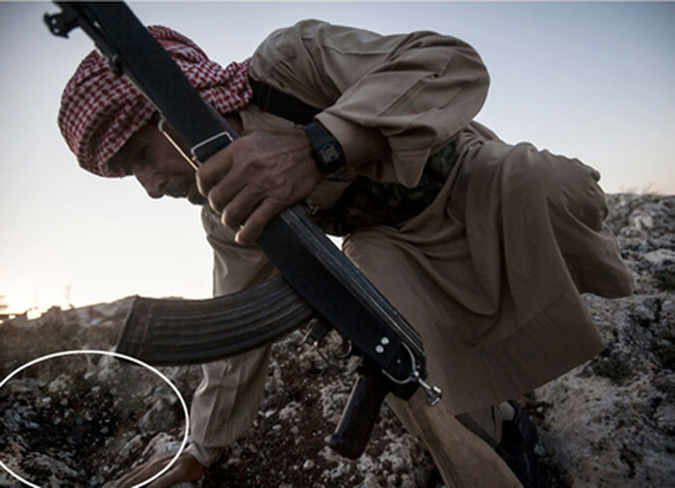
Manipulation of Media by Official Institutions
The issue of image manipulation becomes more serious when official institutions or governments resort to deliberate image forgery. This regardless of the justification, or when media institutions publish images after manipulating them according to official directives or objectives linked to political propaganda.
Directed press images have an immense persuasive ability which make them a powerful tool in the hands of political authority, in view of the information and messages that reach the audience. Because of this, some official media institutions have been known to resort to amending or manipulating images - creating what be called politically oriented media.
Case Study: An Egyptian Blogger Discovers Manipulation in a Government Newspaper
The Egyptian blogger Wael Khalil played an important role in uncovering the manipulation by the Egyptian newspaper Al Ahram of an image taken by the Associated Press photographer Pablo Martinez.
On his blog, Khalil published the manipulated image of former Egyptian President Hosni Mubarak leading the world leaders in the Middle East peace talks. Khalil published beside it the original image showing that President Mubarak was in fact walking behind the Israeli Prime Minister Benjamin Netanyahu, Palestinian President Mahmoud Abbas and Jordan’s King Abdullah II, while the American President Barack Obama was leading the leaders to a press conference at the White House.

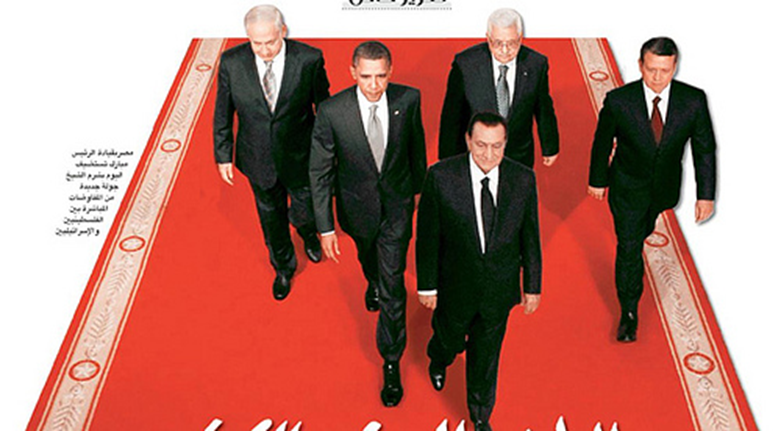
Case Study: The Lebanese Government Manipulates a Protocol Image
There is a tradition in the Lebanese Republic to take a family photo upon the formation of a new government. This is a photo that brings together newly appointed ministers with the President of the Republic, the Speaker of the House and the Prime Minister.
This was the same on 14 February 2014. When it was time to take the photo, and as some new ministers could not arrive on time, the Speaker of the House, Nabih Berri, had to leave because of prior travel plans.
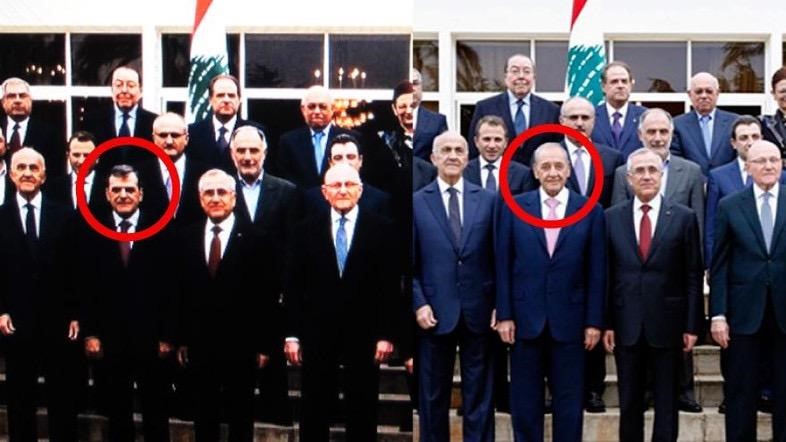
The group photograph of the new government was taken without House Speaker Berri. To make up for this Berri’s image was imposed onto the memorial photo using manipulation software. This was distributed among the local and international press by the photography agency used by the Republican Palace. When the manipulation came to light, the image was removed from many news agency archives, for example Associated Press advised its clients not to publish the image. In doing so, AP’s vice president and director of photography Santiago Lyon noted that: "Adding elements to a photograph is entirely unacceptable and is in clear violation of AP's standards.
This image published by the photography agency accredited by the Lebanese government is not considered real and does not reflect any credibility, whatever the protocol standards are. The original photograph should have been published without any amendment along with the reasons for the absence of Speaker Berri.
It is noteworthy that the image was removed from the archives of foreign news agencies, and Reuters, Agence France Press and the Associated Press all sent their subscribers a warning urging them to delete the image of the new Lebanese government which they had received earlier.
Image Infringement
There may be many cases of digital falsification that have not been discovered, either in view of the skill used in manipulating the image, advancement in photo editing programs, or lack of serious monitoring of photojournalists' work. This process also requires a sufficient number of monitors in international institutions and bodies that work on protecting press images.
It is noteworthy that photo manipulation has been in existence since the birth of photography, albeit on a small scale, as manipulating images when using film cameras required extensive effort and accuracy to edit negatives or paper images, compared with the digital age. With the start of the digital image age in the early nineties, and the development of digital image processing programs, some photographers were encouraged to infringe upon the original image, which contributed to this undermining of credibility.
The manipulation or alteration of an image has become very easy, and it may be acceptable among individuals working in the field of photography art, but it is not acceptable when a photojournalist makes any amendment or manipulates their image. This is considered unethical and unprofessional.
The Meaning of the Non-Manipulation of an Image
Non-manipulation means the image is presented in its complete form.
-
The photographer must not interfere to change the content of the image, along with its positive or negative details, and should refrain from deleting or removing any part of the original photograph.
-
The photographer must also refrain from manipulating the photo’s credibility - meaning that the photographer must be clear and honest with regard to the caption of the image through its accompanying description: who, what, why, when and how. Any description that evades the truth and reality is also a form of manipulation.
-
The photographer must not publish, send or broadcast any image taken on a prior date as if it were taken on a different date, as this is considered misleading. In this case, the photographer or editor must refer to the real date of the photograph, and the reasons that prevented its publication at the time.
Another issue facing us today is that of journalists intervening in the composition of an image. This is when the photographer moves the elements of their subject to suit them. Someone may move the elements of the subject to the right or left, or make them nearer or further, and in many cases, conduct a re-enactment before the camera. This is a type of malpractice that is appearing more frequently in the photojournalism field.
It is never acceptable to ask the persons in the image to make any effort or any movement, and we must take the picture as it is, with its reality and truth.
In this regard, a professional photographer, created controversy when he spoke to a little girl to direct her to light candles following the Brussels bombings that took place on March 22, 2016, before taking his picture that he published on Instagram. This was discovered because the photographer appeared in the background of an interview on a television channel as he was directing the child.
Some considered that the photographer intervened in the image’s course in order to add to the sense of grief, while the photographer defended what he did, saying he did not distribute it among the news agencies, and only published it on his personal Instagram account, but then he deleted it after this controversy. Our goal here is not to make judgments, but this discussion affirms the importance of not interfering in the reality before the image is taken, that our images and opinions on our social media platforms do not negate our responsibility, and that the credibility of our professional work may be impacted as a result.


It should be noted that the photographer later took to Instagram to issue an apology for framing the shot in the way he did, and Pomerantz himself also reacted. He noted on the photographer’s Instagram account that: "I posted the video yesterday knowing nothing about [him], why he was staging a photo or what he intended to do with the resulting photographs. I still know next to nothing (not just about this but about most things in life) but I would imagine that if he’s not feeling pretty s**** about things at this point, he probably never will. Photojournalist or not, he’s first and foremost a human being who it would seem made a mistake and has received some pretty intense public lashings for it. We could use more integrity in the world, not just in photojournalism. The same could be said for empathy and forgiveness.”
Verifying Images of Eyewitnesses
If there are means to check the validity of the images taken by professional journalists working in news agencies, it is difficult to check and ascertain the validity of photographs published on social media by eyewitnesses to events (what is known as UGC).
As discussed in other chapters, there are some useful technical methods in discovering the information accompanying the image, such as date, location, and other important details. The most important step here is to speak to the photographer directly or to the person who sent or published it. These questions should never be avoided:
-
Who are they?
-
Where are they?
-
When did they get there?
-
What can they see (and what does their image show)?
-
Why are they there?
It is important to note if the image was taken in a dangerous location, we must ensure that the eyewitness we communicated with is safe and not at risk as a result of the conversation.
In the event of questioning a certain image, it is best to ask the photographer to send more of the photo series they have taken. This helps determine some additional details.
It is also possible to carry out additional checks to verify the validity of the image and its accompanying information. Here are some useful sites in the search process to examine the image content:
-
Jeffrey’s Exif Viewer: Online tool that reveals Exif information in the images, including date, time and camera settings, and in some instances, GPS coordinates, according to camera type. If the image is taken by phone, this feature must be enforced, or else it is difficult to identify the location.
-
Foto Forensics: This site uses an error level analysis (ELA) to determine any parts that were manipulated in the image. ELA looks for variances in quality in the same image and outlines the areas that may be amended.
-
Google Reverse Image Search: Users can upload the image or enter a link and find similar or related images in addition to sites and pages that used that image.
-
TinEye: Reverse search engine for images which allows internet users to check the source of the image and perhaps its photographer, along with discovering the existence of images, amended copies of them or high resolution copies.
-
JPEGSnoop: An application that operates on Windows only and discovers any amendments made to an image. In spite of its name, it can create AVI, DNG, PDF, THM and embedded JPEG files. It also extracts data such as image date, type of camera, lens settings, and more.
Professional Ethical Considerations
Some media institutions and international agencies have set professional ethics laws and statutes that may be references, for example:
Reuters News Agency
It created a guide for the Agency’s photographers:
A Brief Guide to Standards, Photoshop and Captions
(http://handbook.reuters.com/index.php?title=A_Brief_Guide_to_Standards%2C_Photoshop_and_Captions)
This is a specialised manual in photojournalism, explaining the rules for working within Reuters and respecting photo ethics, including special standards for writing captions, camera settings, and how journalists use photo editing programs such as Photoshop and others.
Associated Press – AP
Code of Ethics for Photojournalists
(http://www.csus.edu/indiv/g/goffs/135%20photojournalism/associated%20press%20ethics%20code.pdf)
The Associated Press created its own rules and principles to be followed by photographers working for the Agency or those who cooperate with it. Like the other institutions, the Associated Press stresses its credibility and warns photographers of manipulating images under any circumstance.
This is in addition to many newspapers, magazines and photo news agencies that stressed credibility and avoiding common mistakes by employees and workers. Most laws and statutes promulgated by media institutions have a special character for its staff or those who cooperate with it; however, they are very similar in their general goals.
National Press Photographers Association (NPPA)
NPPA Code of Ethics (https://nppa.org/code_of_ethics) was drafted by the NPPA, established in 1946 in the US.
This code of ethics is directed at all those working in the photojournalism field, which all professional journalists or journalists just starting their professional career must read and abide by professionally.
The NPPA is a professional association that works to enhance the highest standards in photojournalism and recognises the need for everyone to be fully knowledgeable of public events and to be recognised as a part of the world we live in.
Photojournalists work as trustees for the public. Our main role is to offer visual reports on important events. Our main objective is trustworthiness.
We as photojournalists have a responsibility to document society and preserve its history through images. Photographs and video can reveal great facts such as transgressions and negligence, and they give hope and facilitate communication among all people around the world through the language of visual understanding. They can also cause great damage if they are manipulated.
These instructions aim to achieve the highest levels of quality in all forms of photojournalism and enhance public confidence in this profession. They are also meant to be a teaching tool whether for those who practice photography or those who appreciate photojournalism. In fulfilment of this purpose, the NPPA drafted a list of ethical instructions.
Code of Conduct Instructions
Photojournalists and those who manage the production of visual news are responsible for maintaining the following criteria in their daily work:
-
The image must be accurate and comprehensive in conveying the subjects
-
The photo editors must not manipulate the images
-
The photograph must be complete in the registration of subjects and avoid moulding with individuals and groups. Personal and work biases must be avoided.
-
Treat all subjects with respect and dignity, give special consideration to the subjects who have been subject to harsh circumstances, such as victims of crimes or disasters, and refrain from interfering in private moments such as grief, unless there is a justified need.
-
When photographing subjects, do not purposely contribute to or seek to change events or influence them.
-
When editing images, maintain the soundness of content and the general context of photographs, and refrain from processing images by adding or changing sound (for videos) in any way which may mislead the viewers or distort the subject.
-
Do not pay to the sources or subjects that you photograph any financial award to share the information or access it. (Sources refers to those who arranged the subject for you, while the subject is the person who is photographed or who stands before the photographer to become the subject of the photograph).
-
Gifts, tips or compensation are not accepted from those who seek to influence coverage.
-
Do not sabotage the efforts of other journalists.
Image Processing
All the above on photo examples and codes of ethics and conduct must protect the origins and composition of press images. Our images must always remain as they are.
As for what is permissible to improve the image’s content, it is specifically outlined in the directives of the statutes of the media organisation for which the photographer works.
Generally, these are simple steps which do not impact or change the image’s content, which are processed using Photoshop or other programs:
-
Do not change the image by removing or deleting any element or even any flaws inside the image.
-
Do not copy any element of the elements in the image and paste them on the same image.
-
Do not add any external parts to the image (copy from another picture).
-
The image may be lightened – shaded, but not only a specific part so that it leads to changing the features of the image (dodging – burning).
-
The image may be cropped to improve composition or formation.
-
If the image is enlarged, or a part of the image is used, it must state “enlargement”.
-
The colour balance may be corrected without changing the composition of colour.
-
The dust from dust accumulation problems may be removed from the sensor (clone stamp).
-
The image may be resized.
-
When using Photoshop, a detailed explanation may be written about the image, and a caption may be added so that the photographer avoids responsibility.
Conclusion
The essence of the press image is its credibility. Therefore, we must maintain this by reviewing all material issued by international institutions relevant to press images and follow all guidelines to implement them.
Itidal Salameh writes in her article in the Asharq Al-Awsat newspaper, “The images that forge the truth have a dangerous impact that is no less than forging documents, because in many instances they speak louder than written text. In every angle, they have more accurate details than those that are seen by the eye and do not require explanation, and this may change the course of history in some countries”.
References:
Image no longer available in Reuters archive. Taken from: BBC News (2006, August 6). Reuters drops Beirut photographer. BBC News. Retrieved from: http://news.bbc.co.uk/2/hi/5254838.stm
Image no longer available in Reuters archive. Taken from: BBC News (2006, August 6). Reuters drops Beirut photographer. BBC News. Retrieved from: http://news.bbc.co.uk/2/hi/5254838.stm
Associated Press (2014, January 22). AP severs ties with photographer who altered work. AP. Retrieved from: http://www.ap.org/Content/AP-In-The-News/2014/AP-severs-ties-with-photographer-who-altered-work
Sabti, Bassam (2010, September 16). Egyptian blogger discovers doctored photo in state-run newspaper. International Journalists’ Network. Retrieved from: https://ijnet.org/en/blog/egyptian-blogger-discovers-doctored-photo-state-run-newspaper-0
The photo altered by the Egyptian newspaper was from AP. However, the same photo is available in Reuters image archive, which is the version accessed here.
The altered photograph was originally published by Egyptian newspaper Al Ahram. Taken from: Sabti, Bassam (2010, September 16). Egyptian blogger discovers doctored photo in state-run newspaper. International Journalists’ Network. Retrieved from: https://ijnet.org/en/blog/egyptian-blogger-discovers-doctored-photo-state-run-newspaper-0
An Nahar (2014, February). They succeeded in forming a government and they failed to take a memorial photo! An Nahar. Retrieved from: http://www.annahar.com/article/108723
Recording of Fox News broadcast recorded by James Pomerantz and shared on his Facebook page on March 23 2016. Retrieved from: https://www.facebook.com/jamespomerantz/videos/10102329359726232/
Pomerantz comment was retrieved from: http://petapixel.com/2016/03/24/photojournalist-caught-posing-girl-brussels-memorial/







































